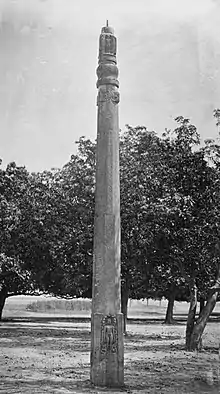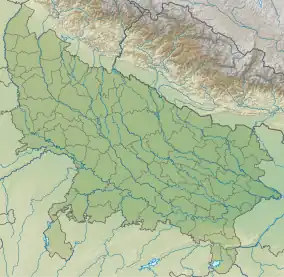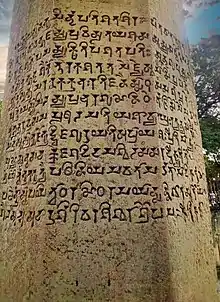Kahaum pillar
Kahaum pillar is an 8 m (26 ft 3 in) structure located in Khukhundoo in the state of Uttar Pradesh. The pillar was erected in the 5th century during the reign of Skandagupta. The pillar has carvings of Parshvanatha and other tirthankars with Brahmi script.[1][2]
| Kahaum pillar | |
|---|---|
 The Kahaum pillar with carving of Parshvanatha and an inscription dating back to 461 CE during the reign of Skandagupta | |
| Material | sandstone |
| Size | 8 metres (26 ft) |
| Created | 5th century CE |
| Period/culture | Gupta Empire |
| Present location | Khukhundoo in Uttar Pradesh, India. |
Description

Kahaum pillar is a grey-sandstone that was erected during the reign of Skandagupta, Gupta Empire[3][4][5] by a Jain ascetic named Madras.[6] According to inscription of the pillar, the pillar was erected in the Jyeshtha month of year 141 of the Gupta era (A.D. 460–61).[7][8]
There is a 0.673 by 0.51 metres (2 ft 2.5 in by 1 ft 8.1 in) on the pillar with writing with characters belonging to eastern variety of Gupta alphabet similar to that of Samudragupta inscription of Allahabad Pillar. The inscription is written in Sanskrit language, and written in verses except for the first word, siddhaṁ.[9] The inscription defines reign of Skandagupta as peaceful and describes him as "commandar of a hundred kings".[10][11] The inscription also has an adoration to Arihant of Jainism.[3][7][12]
There is carving of five Jain Tirthankara in kayotsarga posture — one in a niche square face, two below the circular stone and two on the pinnacle of the column. These images are identified to be of Rishabhanatha, Shantinatha, Neminatha, Parshvanatha and Mahavira.[note 1][14][7][12] According to inscription, these images were carved by Madra who is described as devotee of dvija, guru and yati.[15][16]
Inscription
Skandagupta inscription on the Kahaum pillarSkandagupta inscription on the Kahaum pillar
- Genealogy
[Verse 1] (L.1.) — Perfection has been attained! In the tranquil reign of Skandagupta, whose hall of audience is shaken by the wind caused by the falling down (in the act of performing obeisance) of the heads of a hundred kings; who is bom in the lineage of the Gupta; whose fame is spread far and wide; who excels all others in prosperity; who resembles (the god) Sakra : (and) who is the lord of a hundred kings - in the one hundredth year, increased by thirty and ten and one; the month Jyeshtha having arrived.
- Madra Kingdom
[Verse 2] (L.5.) — In this jewel of a village, which is known by people under the name of Kakubha (and) which is pure from association with holy men, (there was) the high-minded Bhattisoma, who (was) the son of Sdmila, that receptacle of many good qualities. His son (was) Rudrasoma, of great intellect and fame, who had the other appellation of Vyaghra. His son was Madra, who (was) especially full of affection for Brahmans and religious preceptors and ascetics.
- Adoration to Jain Tirthankaras
[Verse 3] (L.9.) — He, being alarmed when he observed the whole of this world (to be ever) passing through a succession of changes, acquired for himself a large mass of religious merit. (And by him ), — having set up, for the sake of final beatitude (and) for the welfare of (all) existing beings five excellent (images), made of stone, (of) those who led the way in the path of the Arhats who practise religious observances, there was then planted in the ground this most beautiful pillar of stone, which resembles the tip of the summit of the best of mountains, (and) which confers fame (upon him).
Notes
- Rishabhanatha, Shantinatha, Neminatha, Parshvanatha and Mahavira attract the most devotional worship among the Jains.[13]
References
Citation
- "Jain shrines". Uttar Pradesh Tourism. Retrieved 17 September 2020.
- Sharma, Tej Ram (1978). Personal and Geographic Names in Gupta Inscriptions (PDF). p. 93.
- Dikshitar 1993, p. 332.
- The Asiatic Society 1892, p. 62.
- Mukherjee 1989, p. 90.
- Sharma, Tej Ram (1978). Personal and Geographic Names in Gupta Inscriptions (PDF). p. 93.
- Bhandarkar 1981, p. 306.
- Vajpeyi 1983, p. 73.
- Fleet 1888, p. 66.
- Dani & Litvinsky 1996, p. 123.
- Singh 2017, p. 346.
- Deo 1954, p. 103.
- Dundas 2002, p. 40.
- Bhattacharya 1974, p. 15.
- Singh 2008, p. 524.
- Singh 2017, pp. 346–347.
- Fleet 1888, pp. 67–68.
- Bhandarkar 1981, pp. 307–308.
Books
- Bhandarkar, Devadatta Ramakrishna (1981). Chhabra, Bahadur Chand (ed.). Corpus Inscriptionum Indicarum (Revised) (PDF). Vol. 3. Archaeological Survey of India.
- Bhattacharya, B. C. (1974) [1939]. The Jain Iconography (PDF) (2nd ed.). Motilal Banarsidass.
- Dikshitar, V. R. Ramachandra (1993). The Gupta Polity. Motilal Banarsidass. ISBN 9788120810242.
- Dani, Ahmad Hasan; Litvinsky, B. A. (1996). History of Civilizations of Central Asia: The crossroads of civilizations, A.D. 250 to 750. History of Civilizations of Central Asia. Vol. 3. UNESCO. ISBN 9789231032110.
- Dundas, Paul (2002) [1992], The Jains (Second ed.), Routledge, ISBN 0-415-26605-X
- Fleet, John Faithfull (1888). Corpus Inscriptionum Indicarum. Vol. 3. Calcutta: Superintendent of Government Printing.
- Higham, Charles (2014). Encyclopedia of Ancient Asian Civilizations. Facts on File Library of World History. Infobase Publishing. ISBN 9781438109961.
- Mukherjee, Radha Kumud (1989) [1973]. The Gupta Empire (Fifth ed.). Delhi: Motilal Banarsidass. ISBN 81-208-0440-6.
- Singh, Upinder (2008). A History of Ancient and Early Medieval India: From the Stone Age to the 12th Century. Pearson Education. ISBN 978-81-317-1677-9.
- Singh, Upinder (2017). Political Violence in Ancient India. Harvard University Press. ISBN 9780674981287. LCCN 2017008399.
- Sinha, Bindeshwari Prasad (1977). Dynastic History Of Magadha. Abhinav Publications. ISBN 9788170170594.
- The Asiatic Society (1892). Proceeding of the Asiatic Society of Bengal. Baptist Misson Press.
Web
- Deo, S. B. (1954). "The History of Jaina Monachism from Inscriptions and Literature". Bulletin of the Deccan College Research Institute. Deccan College Post-Graduate and Research Institute. 16 (1/4): 1–608. JSTOR 42929542. OCLC 555200984. Retrieved 8 July 2022.
- Vajpeyi, Raghavendra (1983). "Skandagupta's Bhitari Grant To Visnu-sarngin And Bhitari Excavations". Proceedings of the Indian History Congress. Indian History Congress. 44: 70–78. JSTOR 44139823.
External links
![]() Media related to Kahaum pillar at Wikimedia Commons
Media related to Kahaum pillar at Wikimedia Commons



